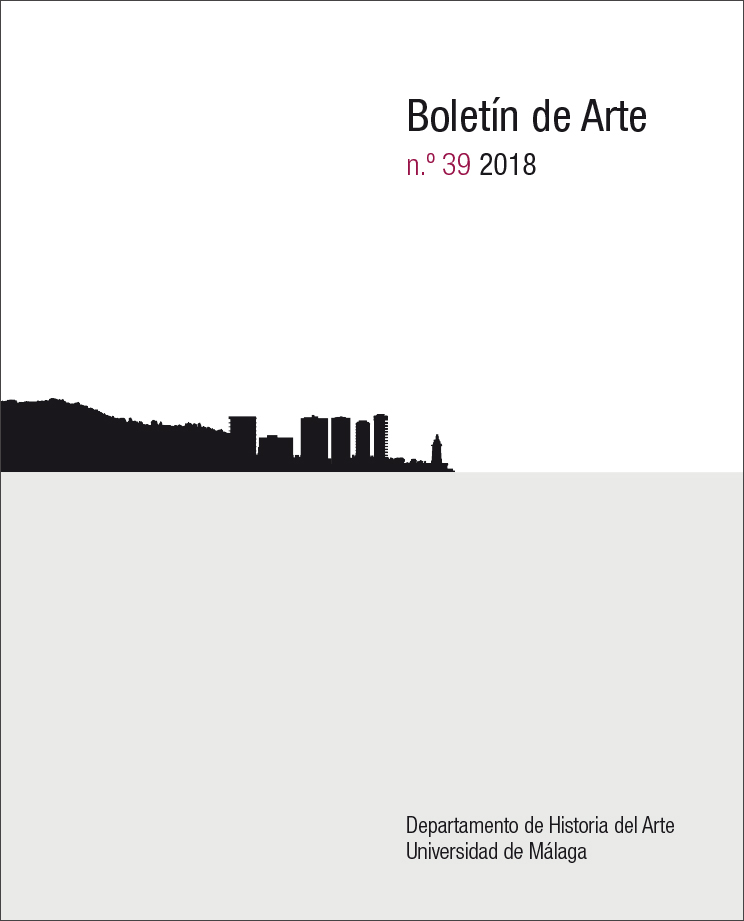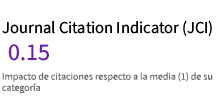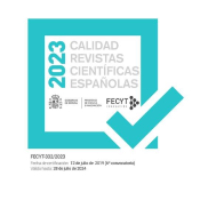Processional and Wayside Crosses. Theological and Social Significance of their Iconographic Particularities
DOI:
https://doi.org/10.24310/BoLArte.2018.v0i39.4246Abstract
The kingdom of Valencia, other realms of the Crown of Aragon and the rest of the Iberian peninsula, proved to have a particular propensity for the erection of wayside crosses. The few academic studies that have paid attention to them have only taken into account their stylistic aspect, which has led a good few researchers to compare these works with goldsmiths´ crosses. But beyond the decoration, their subjects differ substantially. The location of the wayside crosses, outside the ecclesiastic area, their medium and especially their utility might have determined the iconographic differences with regard to other crosses and hence the theological implications of the different types of crosses. The processional crosses were part of the liturgical ritual of the Church, whereas the wayside crosses were part of the daily life of the community and they answer, therefore, to popular religiousity rather than to the official religion.
Downloads
Metrics
Publication Facts
Reviewer profiles N/A
Author statements
Indexed in
-
—
- Academic society
- N/A
- Publisher
- Universidad de Málaga.
References
BANGO TORVISO, Isidro G. (1984), “La Virgen y el Tetramorfos”, Boletín del Museo e Instituto Camón Aznar, 15, pp. 15-17.
BELTING, Hans (2007), Antropología de la imagen, Katz, Buenos Aires.
BENSON, George W. (1982), The cross. Its history and symbolism, Harcher Art Books, Nueva York.
COTS MORATÓ, Francisco de Paula (2012), “Símbolo y visualidad en las cruces procesionales valencianas. (SS. XIV-XX)”, Laboratorio de arte, 24, pp. 47-74.
DE CARLOS, Mª Cruz, “Museo Arqueológico Nacional. Pieza del mes. Ciclo 1999-2001. Creencias, símbolos y ritos religiosos. Cruz procesional. La liturgia católica. Sala 37”. En <http://www.man.es/man/dms/man/actividades/pieza-del-mes/historico/2001-creencias-simbolos-y-ritos-religiosos-3/8-noviembre/MAN-Pieza-mes-2001-11-Cruz-procesional.pdf> (20-11-17).
DURAN-PORTA, Joan (2009), “Adam o Llàtzer? Notes iconogràfiques al voltant de les creus processionals catalanes”, Randa, 62, pp. 41-58.
FAISON, Samson L. (1935), “A Gothic Processional Cross in the Museo Cristiano”, The Art Bulletin, 17, pp. 163-183.
FAVÀ MONLLAU, Cèsar (2005-2006), “El retaule eucarístic de Vilafermosa i la iconografia del Corpus Christi a la Corona d’Aragó”, Locus Amoenus, 8, pp. 105-121.
GONZÁLEZ HERNANDO, Irene (2011), “El Tetramorfo”, Revista Digital de Iconografía Medieval, 3, 5, pp. 61-74. En (20-11-17).
GRACIA BENEYTO, Carmen (1998), Arte Valenciano, Cátedra, Madrid.
HERRÁEZ ORTEGA, María Victoria (1994), “Orfebrería y liturgia en la Baja Edad Media. El programa iconográfico de la custodia procesional de Córdoba”, Anales de la Historia del Arte, 4, pp. 783-791.
HOURIHANE, Colum (2005), The Processional Cross in Late Medieval England. The ‘Dallye Cross’, The Society of Antiquaries of London, Londres.
LLOMPART MORAGUES, Gabriel (1974), “La orfebrería mallorquina en torno a 1400”, Mayurqa, 12, pp. 87-121.
MARTIN, Hervé; MARTIN, Louis (1977), “Croix rurales et sacralisation de l’espace. Le cas de la Bretagne au Moyen Age/Rural Crosses and Sacralization of Space. Brittany in the Middle Ages”, Archives de Sciences Sociales des Religions, 43, 1, enero-marzo, pp. 23-38.
MOCHOLÍ MARTÍNEZ, María Elvira (2008), “Cruces, caminos y muerte”, en GARCÍA MAHÍQUES, Rafael; ZURIAGA SENENT, Vicent (eds.), Imagen y cultura. La interpretación de las imágenes como historia cultural, Biblioteca Valenciana, Valencia, vol. II, pp. 1097-1116.
MOCHOLÍ MARTÍNEZ, María Elvira (2008), “Xàtiva en la encrucijada. La cruz del camino de Valencia”, Ars Longa. Cuadernos de Arte, 17, pp. 13-23.
MOCHOLÍ MARTÍNEZ, María Elvira (2017a), Las imágenes conceptuales de María en la escultura valenciana medieval, tesis doctoral, Universitat de València.
MOCHOLÍ MARTÍNEZ, María Elvira (2017b), “Ostentatio eucharistiae. La significación eucarística de las cruces de término en Valencia a finales de la Edad Media”, en BALLESTER MORELL, Blanca y otros (eds.), Encrucijada de la palabra y la imagen simbólicas. Estudios de emblemática, José J. de Olañeta Editor, Palma, pp. 481-494.
NELSON, James (1952), The Medieval Churchyard and Wayside Crosses of Warwickshire, Oxford University Press, Oxford.
PITARCH I VIVES, Teòfil (coord.) (2005), Vallibona/Pena-roja de Tastavins. Fraternitas Saecularis, Diputación de Castellón, Castellón de la Plana.
RÉAU, Louis (2006), Iconografía del arte cristiano. 1.2. Iconografía de la Biblia. Nuevo Testamento, Serbal, Barcelona.
RUBIN, Miri (1992) “The Eucarist and the Construction of Medieval Identities”, en AERS, David (ed.), Culture and History, 1350-1600: Essays on English Communities, Identities and Writing, Wayne State University Press, Detroit, pp. 43-63.
SIMÓ CASTILLO, Juan B. (1986), El Maestrat para andar y ver, Radio Nueva, Vinaroz.
ZARAGOZÁ CATALÁN, Arturo (1999), “Sueños de arquitecturas en el episodio gótico valenciano”, Penyagolosa, 1, pp. 9-18.
Downloads
Additional Files
Published
How to Cite
Issue
Section
License
Todos los contenidos publicados en la revista Boletín de Arte están sujetos a la licencia Creative Commons Reconocimento-NoComercia-Compartirigual 4.0 cuyo texto completo puede consultar en <http://creativecommons.org/licenses/by-nc-sa/4.0>

Los/as autores/as cuyas contribuciones sean aceptadas para su publicación en esta revista conservarán el derecho no exclusivo de utilizar sus contribuciones con fines académicos, de investigación y educativos, incluyendo el auto-archivo o depósito en repositorios de acceso abierto de cualquier tipo.
La edición electrónica de esta revista esta editada por la Editorial de la Universidad de Málaga (UmaEditorial), siendo necesario citar la procedencia en cualquier reproducción parcial o total.












4.png)
